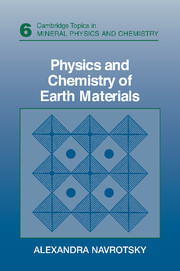Book contents
- Frontmatter
- Contents
- Acknowledgments
- 1 Introduction
- 2 Crystal chemistry
- 3 Experimental methods for studying structure
- 4 Methods for studying thermodynamic properties
- 5 Chemical bonding
- 6 Mineral thermodynamics
- 7 Solid solutions and order–disorder
- 8 Melts, glasses, and amorphous materials
- 9 The interface between mineral physics and materials science
- Index
8 - Melts, glasses, and amorphous materials
Published online by Cambridge University Press: 05 June 2012
- Frontmatter
- Contents
- Acknowledgments
- 1 Introduction
- 2 Crystal chemistry
- 3 Experimental methods for studying structure
- 4 Methods for studying thermodynamic properties
- 5 Chemical bonding
- 6 Mineral thermodynamics
- 7 Solid solutions and order–disorder
- 8 Melts, glasses, and amorphous materials
- 9 The interface between mineral physics and materials science
- Index
Summary
Introduction
Silicate melts, as magmas at depth, lavas on the surface, and transient phases on meteor impact, play important roles in geochemical and cosmochemical processes. A natural silicate melt contains SiO2, A12O3, MgO, CaO, iron oxides, and alkalis as major components, with minor to trace amounts of TiO2, P2O5, transition metals, and rare earths, and minor but significant amounts of volatiles, notably H2O, CO2, SO2, and HF. The complete description of the structure, properties, and reactions of such a complex multicomponent melt at temperatures of 800 K to 2200 K and pressures of 1 atmosphere to 30 GPa is an immense task; the understanding of these properties in terms of fundamental atomic-level chemical interactions is even more formidable. Therefore many different approaches have been taken, ranging from theoretical and experimental studies of simple model systems to largely empirical studies of simulated or actual rock compositions.
Many silicate melts form glasses, rigid but noncrystalline materials, upon reasonably rapid cooling. Glasses and glass-crystal mixtures (so called glass ceramics) are technologically important. The relation of this dynamically “frozen” state to the liquid and the glass transition separating these two regions raise fundamental questions of physics and chemistry. In addition, noncrystalline (amorphous) materials can be made by a variety of methods other than quenching from a liquid. These include chemical vapor deposition, sol-gel processing and precipitation from aqueous solution, radiation damage, and pressure amorphization.
- Type
- Chapter
- Information
- Physics and Chemistry of Earth Materials , pp. 371 - 407Publisher: Cambridge University PressPrint publication year: 1994



